Portage Learning Anatomy & Physiology 2: Module 1 Exam
1/54
There's no tags or description
Looks like no tags are added yet.
Name | Mastery | Learn | Test | Matching | Spaced |
|---|
No study sessions yet.
55 Terms
This is a collection of cell bodies found in the peripheral nervous system.
Ganglia
This is a bundle of axons found in the peripheral nervous system.
Nerve
This part of a neuron conducts nerve impulse away from the cell body.
Axon
This part of a neuron conducts nerve impulses towards the cell body.
Dendrites
What part of the autonomic system accelerates the heart beat and increases breathing rate?
Sympathetic nervous system
What part of the autonomic system increases digestion?
Parasympathetic
An interneuron inside the spinal cord is part of the:
Central nervous system
An afferent neuron carries information:
A) From the central to the peripheral nervous system
B) From the peripheral to the central nervous system
C) Within the central nervous system
D) Within the peripheral nervous system
B) From the peripheral to the central nervous system
An efferent neuron carries information:
A) From the central to the peripheral nervous system
B) From the peripheral to the central nervous system
C) Within the central nervous system
D) Within the peripheral nervous system
A) From the central to the peripheral nervous system
A neuron going to the bicep of the forearm is part of the:
A. Central nervous system
B. Peripheral nervous system
C. Autonomic system
D. Somatic system
E. A&C
F. B&D
F. B&D
What is the location and function of Satellite cells?
Located in the PNS and function is to regulate the environment of neuron cell bodies
What is the location and function of Astrocytes?
Located in the CNS and the function is to regulate chemical environment inside CNS
The neuron pictured, below, is best described as:
A) Bipolar
B) Multipolar
C) Unipolar
D) Pseudounipolar
A) Bipolar
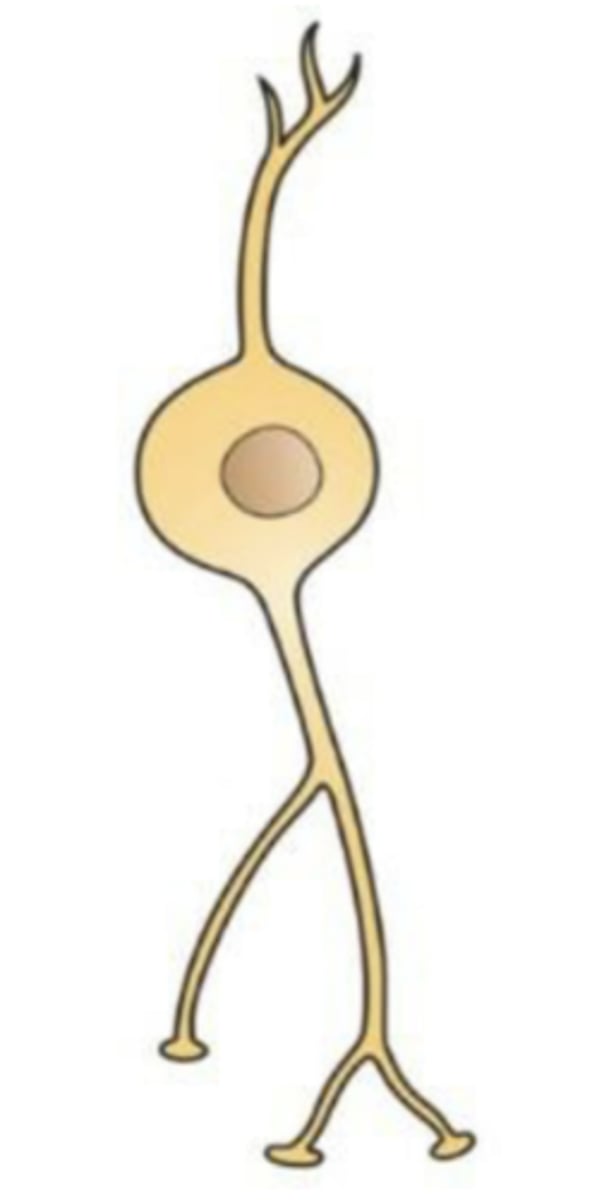
The neuron pictured, below, is best described as:
A) Bipolar
B) Multipolar
C) Unipolar
D) Pseudounipolar
B) Multipolar

The neuron pictured, below, is best described as:
A) Bipolar
B) Multipolar
C) Unipolar
D) Pseudounipolar
C) Unipolar
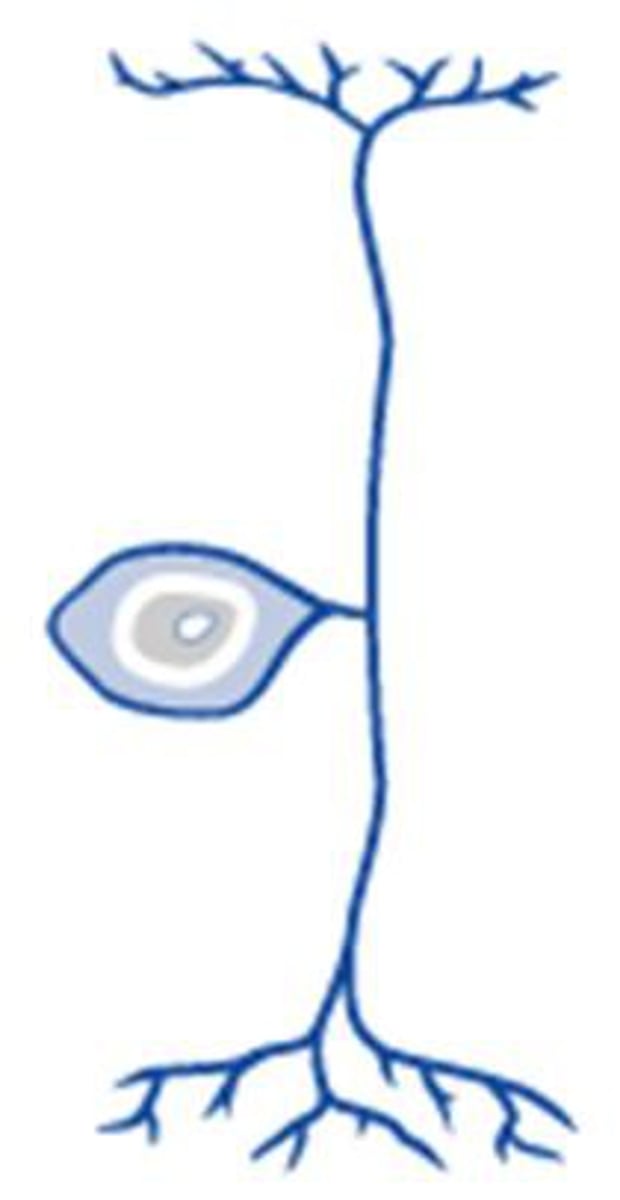
True or false: Neurons do not physically touch one another.
True
True or False: Neurons come into direct physical contact with one another.
False
True or False: Action potentials travel in multiple directions within the same neuron.
False- only one direction in the same neuron
How is a message sent from one neuron to another?
When a nerve impulse reaches the end of an axon, neurotransmitters are released into the synapse. Depolarization happens and impulse continues to travel
Describe the function and release of neurotransmitters:
Neurotransmitters are chemicals stored at the ends of neuron. When released, they help pass messages from one neuron to another.
Describe the synthesis and storage of neurotransmitters.
Synthesized by neuron cell body and stored in the synapse vesicle at the axon end terminal
A presynaptic neuron would be found:
A) Before the synapse
B) After the synapse
C) Inside the synapse
D) Only in the peripheral nervous system
A) Before the synapse
A postsynaptic neuron would be found:
A) Before the synapse
B) After the synapse
C) Inside the synapse
D) Only in the peripheral nervous system
B) After the synapse
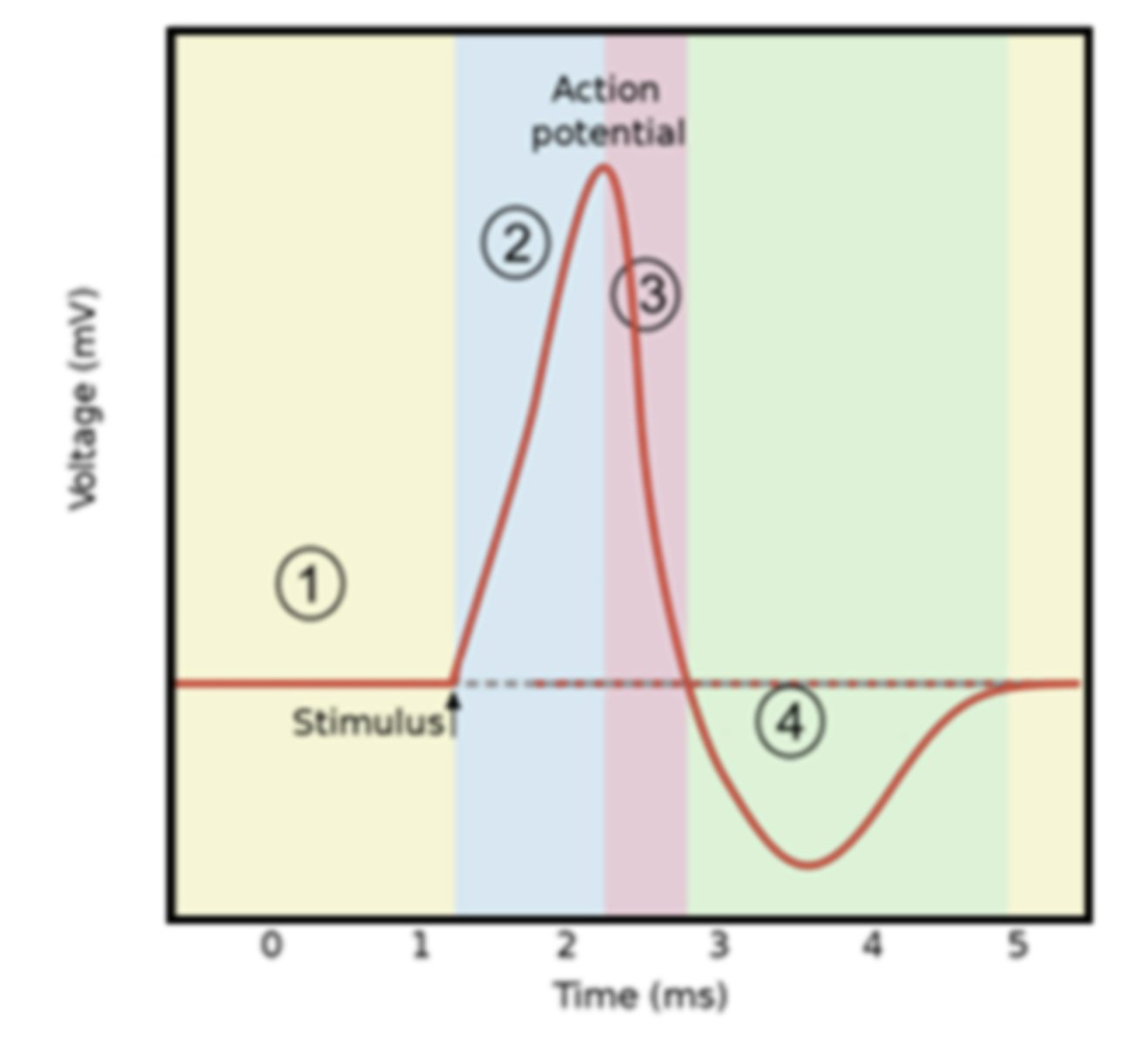
Name and describe what is occurring in the neuron cell membrane in phase 1 of the diagram. Include the charge of the membrane during this phase.
Phase 1 is resting potential. Both sodium and potassium gates are closed and the voltage of the membrane is at -70 mV
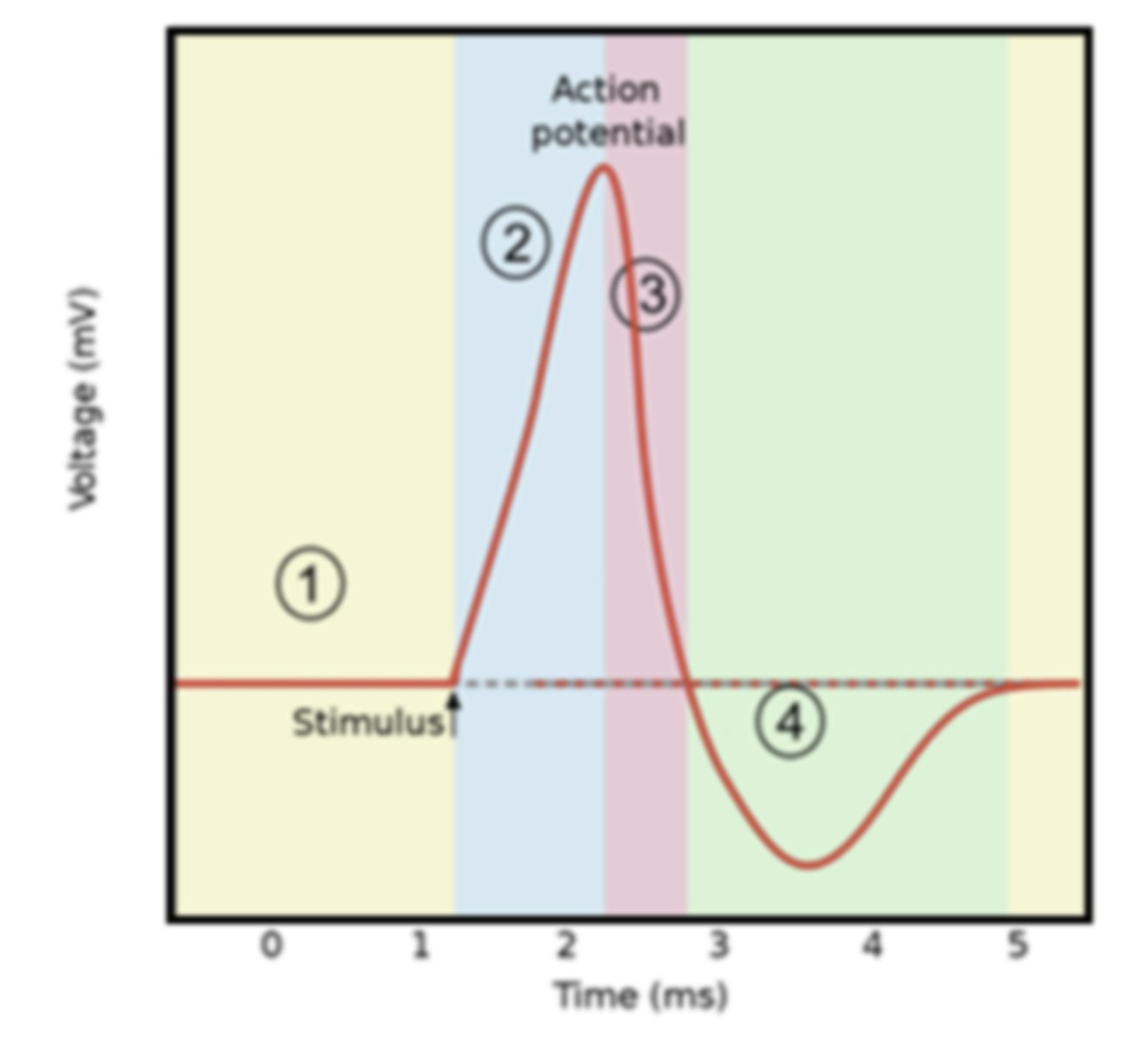
Name and describe what is occurring in the neuron cell membrane in phase 2 of the diagram. Include the charge of the membrane during this phase.
Phase 2 is depolarization. The sodium gates open, and sodium rushes into the axon. Voltage goes from -70 mV to +40 mV.
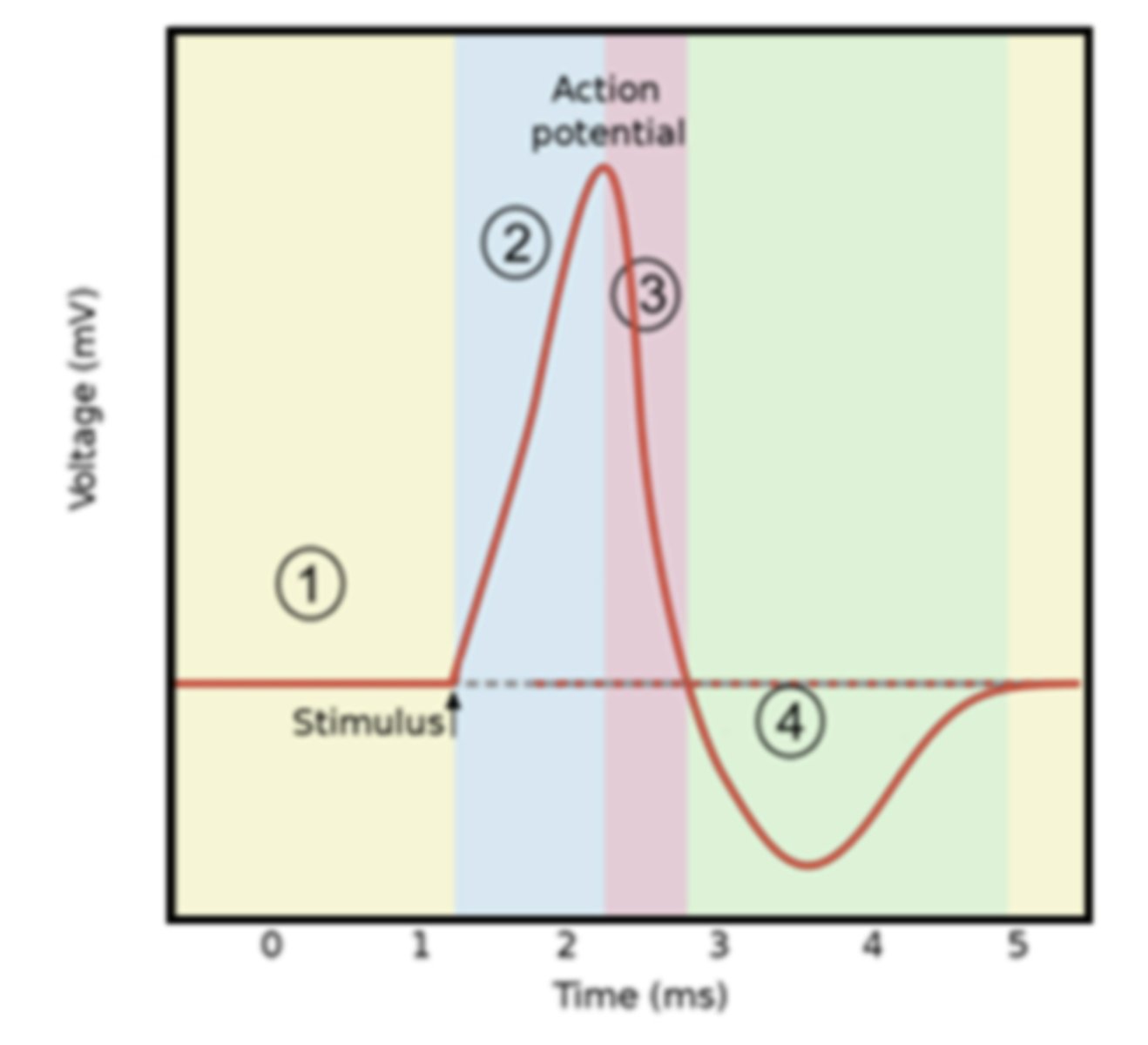
Name and describe what is occurring in the neuron cell membrane in phase 3 of the diagram. Include the charge of the membrane during this phase.
Phase 3 is repolarization. During this phase, Na+ gates close and K+ gates open allowing K+ to rush out of the axon. The voltage of membrane will change from +40mV to -70mV
Name and describe what is occurring in the neuron cell membrane in section 4 of the diagram. Include the charge of the membrane during this phase.
Section 4 is hyperpolarization. K+ gates close slowly and the charge drops below -70mV and then returns to -70mV at resting state
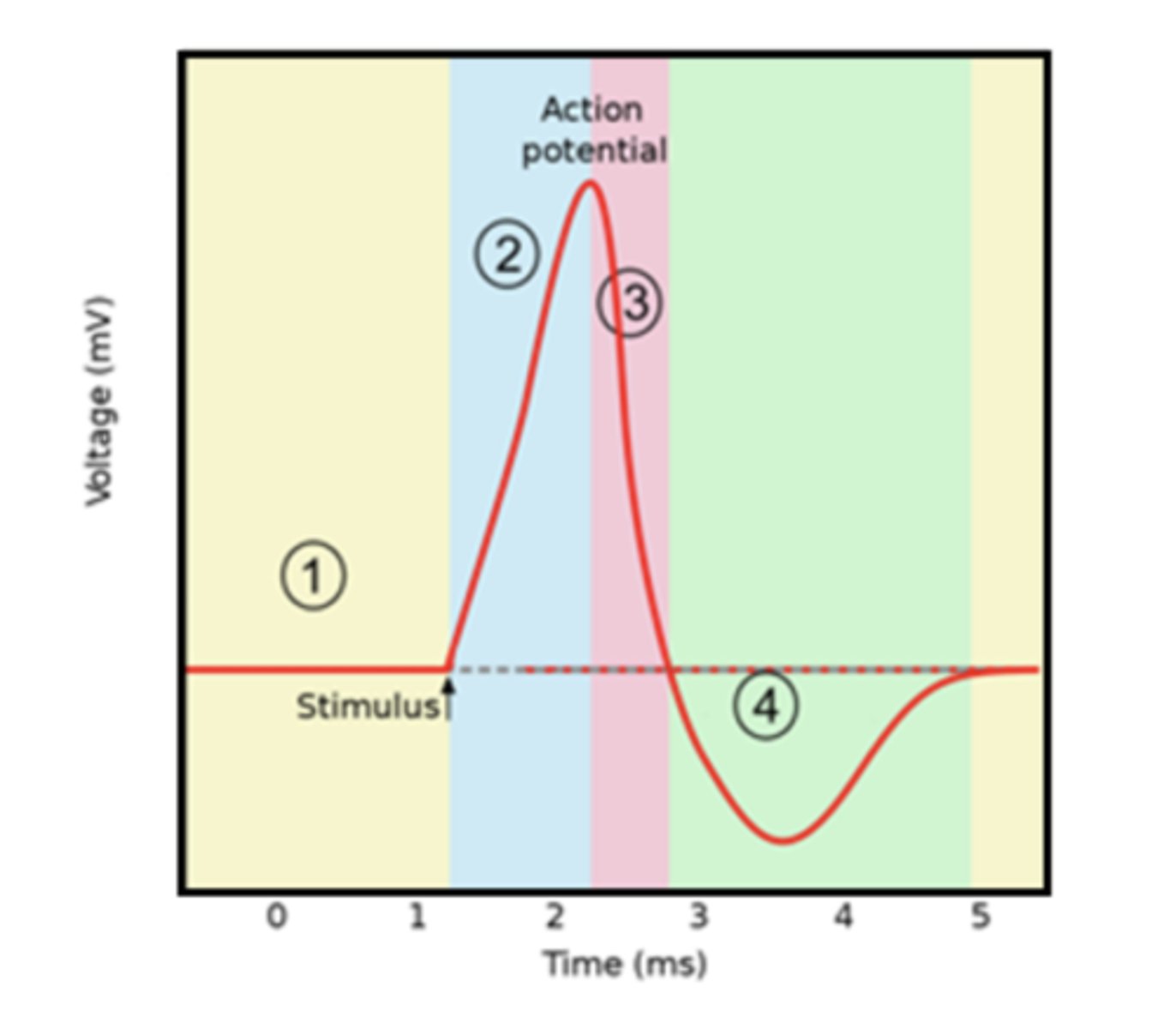
At rest, a neuron plasma membrane is:
A) 0 mV
B) +40 mV
C) Polarized (around -70mV)
D) Depolarized
C) Polarized (around -70mV)
Which of the following is TRUE regarding the Sodium potassium pump?
a. It maintains the depolarization phase of an axon.
b. For every two sodium ions pumped out, three potassium ions are pumped in.
c. It must remain in constant operation to maintain the resting state.
d. The overall effect is a positive charge on the inside of the membrane.
c. It must remain in constant operation to maintain the resting state.
Which of the following is FALSE concerning the sodium-potassium pump?
A) It maintains the resting phase of an axon.
B) For every three sodium ions pumped out, two potassium ions are pumped in.
C) It must remain in constant operation to maintain the resting state.
D) The overall effect is a negative charge on the outside of the membrane
D) The overall effect is a negative charge on the outside of the membrane. (False, the effect of the pump is a negative charge inside the membrane, positive on the outside.)
True or false: A sensory neuron is signaling the body of extreme pain. This means that the strength of the action potential is greater than usual. Explain your reasoning.
False because this is an all or nothing response, the strength of the action potential will not differ. Only the number of neurons firing and frequency differs.
Which of the following statements is TRUE concerning the neuromuscular junction?
A) The NMJ terminates on neurons within the brain and spinal cord.
B) The NMJ terminates on a muscle fiber.
C) The NMJ terminates on a presynaptic motor neuron.
D) The NMJ does not have a synapse.
B) The NMJ terminates on a muscle fiber.
What neurotransmitter is found at the neuromuscular junctions?
Acetylcholine
True or False: Reflexes occur only with conscious intervention from the brain.
False
The ventral root of a nerve contains what type of neurons?
motor neurons
Where is the integration center of a reflex located?
CNS
Which of the following statements is FALSE about reflexes?
A) Reflexes do not require higher levels of voluntary processing from the brain.
B) Regulation of blood sugar by hormones is one example of a reflex.
C) Some reflexes can be tested to determine injury.
D) Pulling a hand away from a hot flame is not a reflex; it is entirely voluntary.
D) Pulling a hand away from a hot flame is not a reflex; it is entirely voluntary.
What is TRUE about the stretch reflex?
A) Stretch reflexes help to increase the stretch on a muscle.
B) The patellar reflex tests the stretch reflex of the patella.
C) The muscle spindle detects stretch within the muscle.
D) The effect of the motor signal is to relax a muscle.
C) The muscle spindle detects stretch within the muscle.
What is TRUE about the flexor withdrawal reflex?
A. It does not involve interneurons.
B. It involves excitatory interneurons.
C. It involves inhibitory interneurons.
D. The effect of the reflex is to create a co-contraction of two muscles
E. A&D
F. B&C
F. B&C
Answer the following essay questions:
You touch a hot pan when cooking. List out the steps, in detail, of the nervous pathway of the reflex that occurs. Include any sensory organs involved and the action of the reflex.
pain receptor send signal toward CNS
Signal travel through sensory nerve and connect with interneuron
Excitatory interneuron activate motor neurons, contracting bicep and flex elbow to move arm away.
Inhibitory interneuron inactivates tricep contraction to not interfere with action.
Answer the following essay questions:
Botulism is a disease caused by a neurotoxin that interferes with the release of Acetylcholine. Patients with this disease experience flaccid paralysis, or the inability to contract their muscles. Explain why this would occur.
Release of Acetylcholine cause muscle contrations by the nervous and muscular system working together, so interfering with the release of acetylcholine will cause no interaction between the two systems which leads to no contraction
The dorsal root of a nerve contains what type of neurons?
Sensory neurons
Answer the following essay questions:
A patient's spinal cord was severed in a car accident. Would the patient be expected to regrow axons in their spinal cord? Why or why not?
No because spinal cord is a part of CNS, and only PNS can regrow axons. So spinal cord cannot regrow axons.
Answer the following essay questions:
A patient's left thumb was severed in a cooking accident and then reattached during surgery. Would the patient be expected to regrow axons in their thumb? Why or why not?
Yes because PNS can regrow axons via axonal regeneration
Answer the following essay questions:
A sensory neuron is signaling the body of a light touch. Does this mean that the strength of the action potential is weaker than usual?
False because this is an all or nothing response, the strength of the action potential will not differ. Only the number of neurons firing and frequency differs.
Which of the following statements is FALSE concerning the neuromuscular junction?
a. Sodium ions release from the presynaptic motor neuron.
b. Calcium ions release from the sarcoplasmic reticulum to cause muscle contraction.
c. Sodium channels open on the muscle fibers in response to the neurotransmitter.
d. The NMJ is found in the peripheral nervous system
a. Sodium ions release from the presynaptic motor neuron.
What neurotransmitter helps regulate emotional responses and muscle tone?
Dopamine
True or False: Action potentials travel in one direction within the same neuron.
True
Which of the following statements is TRUE about reflexes?
a. Reflexes only involve the brainstem or higher levels of processing.
b. Regulation of blood sugar by hormones is one example of a reflex.
c. Reflexes cannot be tested because they are internal.
d. Pulling a hand away from a hot flame is not a reflex; it is entirely voluntary.
b. Regulation of blood sugar by hormones is one example of a reflex.
What is FALSE about the flexor withdrawal reflex?
a. It does not involve interneurons.
b. It involves excitatory interneurons.
c. It involves inhibitory interneurons.
d. The effect of the reflex is to create a co-contraction of two muscles.
e. A & D
f. B & C
e. A & D
What is FALSE about the stretch reflex?
a. The effect of the motor signal is to relax a muscle.
b. The patellar reflex tests the stretch reflex of the quadriceps femoris.
c. The muscle spindle detects stretch within the muscle.
d. Stretch reflexes help to decrease the stretch on a muscle.
a. The effect of the motor signal is to relax a muscle
Which of the following statements is TRUE about the stretch reflex?
a. Stretch reflexes help to increase the stretch on a muscle.
b. The patellar reflex tests the stretch reflex of the patella.
c. The muscle spindle detects stretch within the muscle.
d. The effect of the motor signal is to relax a muscle.
c. The muscle spindle detects stretch within the muscle
Answer the following essay questions:
Your doctor taps on your patellar tendon. List out the steps, in detail, of the nervous pathway of the reflex he is testing. Include any sensory organs involved and the action of the reflex.
1. patellar tendon is tapped and the muscle spindle detects stretch
2. Sensory nerve carries the signal to the spinal cord and connects with a motor nerve.
3. motor nerve sends signal back to the same muscle
4. Quadricep muscle contract to prevent overstretching
Answer the following essay questions:
Multiple Sclerosis is an autoimmune disease which attacks the myelin sheath of the nerve axon. Patients with this disease may experience difficulty using the muscles of their arms and legs. Explain why this would occur.
Myelin helps nerves send signals faster and protects them. If myelin is damaged, signals slow down and the nerve can be permanently damaged
Answer the following essay questions:
What prevents continuous stimulation of a nerve synapse and how is this accomplished?
Short existence from the neurotransmitters prevent continuous stimulation and is accomplished by the enzymes in synpase that stops and absorbs the neurotransmitters